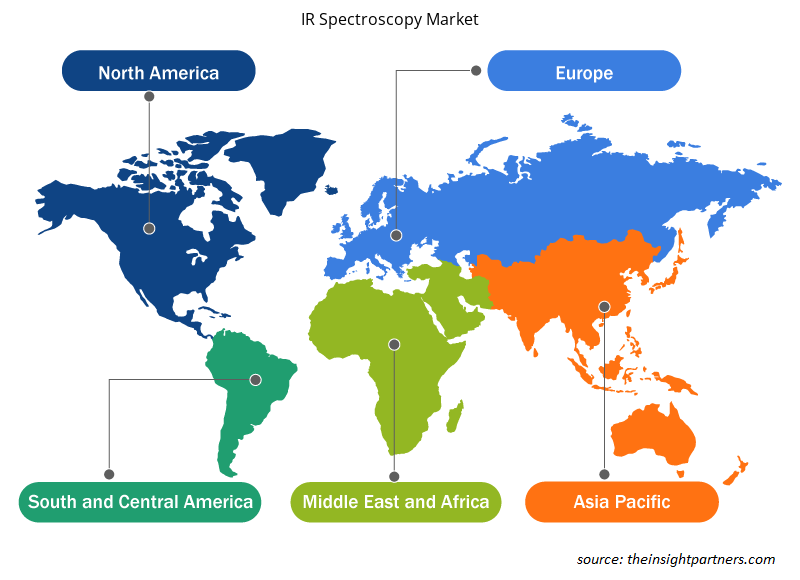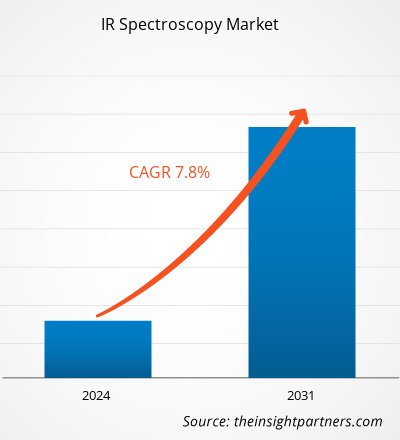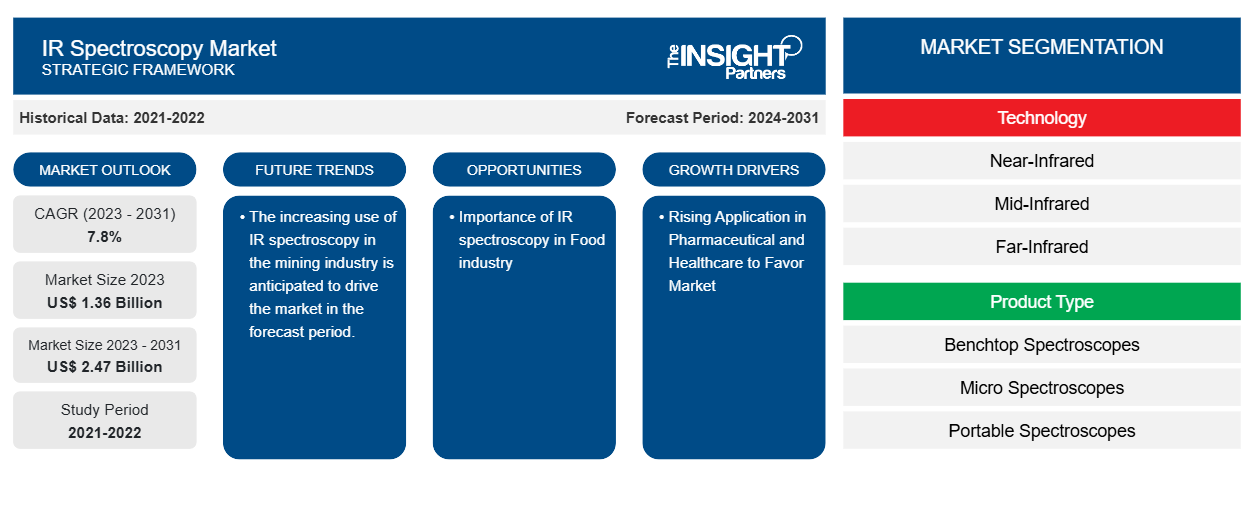Le marché de la spectroscopie IR devrait atteindre 2,47 milliards USD d'ici 2031, contre 1,36 milliard USD en 2023. Le marché devrait enregistrer un TCAC de 7,8 % au cours de la période 2023-2031. L'augmentation des applications dans les secteurs pharmaceutique et de la santé et la croissance émergente dans l'industrie alimentaire devraient rester des tendances et des moteurs clés du marché.
Analyse du marché de la spectroscopie IR
La demande pour le marché de la spectroscopie IR devrait augmenter avec le nombre croissant d'établissements médicaux et de centres de recherche clinique à travers le monde. En outre, l'application croissante dans l'industrie pharmaceutique et de la santé et l'intérêt croissant de la spectroscopie IR dans les économies émergentes. De plus, le marché devrait croître avec l'essor de l'industrie alimentaire.
Aperçu du marché de la spectroscopie IR
La spectroscopie infrarouge (spectroscopie IR) est la spectroscopie qui traite de la région infrarouge du spectre électromagnétique, c'est-à-dire de la lumière ayant une longueur d'onde plus longue et une fréquence plus basse que la lumière visible. Elle couvre une gamme de techniques, principalement basées sur la spectroscopie d'absorption. Comme toutes les techniques spectroscopiques, elle peut être utilisée pour identifier et étudier les produits chimiques.
Personnalisez ce rapport en fonction de vos besoins
Vous bénéficierez d'une personnalisation gratuite de n'importe quel rapport, y compris de certaines parties de ce rapport, d'une analyse au niveau des pays, d'un pack de données Excel, ainsi que de superbes offres et réductions pour les start-ups et les universités.
-
Obtenez les principales tendances clés du marché de ce rapport.Cet échantillon GRATUIT comprendra une analyse de données, allant des tendances du marché aux estimations et prévisions.
Facteurs moteurs et opportunités du marché de la spectroscopie IR
L'augmentation des applications dans le secteur pharmaceutique et des soins de santé devrait favoriser le marché
Les personnes âgées du monde entier souffrent actuellement de divers troubles psychiatriques et neurologiques . De plus, les fonctions cérébrales de ces patients sont profondément altérées, ce qui limite leur indépendance dans la vie quotidienne. Dans ces cas, la spectroscopie IR est essentielle. En outre, la spectroscopie proche infrarouge est utilisée dans la synthèse et la purification des principes actifs pharmaceutiques (API) et des fermentations biopharmaceutiques . Cette technologie est idéale car elle a été conçue pour analyser des mélanges complexes.
Importance de la spectroscopie IR dans l'industrie alimentaire.
Au cours des dernières années, la méthode de spectroscopie infrarouge pour l'analyse des aliments a considérablement évolué. La spectroscopie infrarouge peut être utilisée pour effectuer une analyse de qualité sur plusieurs familles de groupes alimentaires tels que la viande, les fruits, le poisson, les légumes, les produits laitiers, les œufs et les céréales. Au fur et à mesure que la technique de spectroscopie infrarouge s'est développée et a évolué dans son application à l'analyse des aliments, elle est finalement devenue un outil fiable et puissant. La méthode présente divers avantages qui en font l'outil d'analyse approprié pour de nombreux groupes et entreprises alimentaires.
Analyse de segmentation du rapport sur le marché de la spectroscopie IR
Les segments clés qui ont contribué à l’élaboration de l’analyse du marché de la spectroscopie IR sont la technologie, le type de produit et l’utilisateur final.
- Sur la base de la technologie, le marché de la spectroscopie IR est divisé en proche infrarouge, infrarouge moyen et infrarouge lointain. Le segment proche infrarouge devrait détenir une part de marché importante au cours de la période de prévision.
- En fonction du type de produit, le marché de la spectroscopie IR est divisé en spectroscopes de paillasse , microspectroscopes, spectroscopes portables et spectroscopes à trait d'union. Le segment des spectroscopes de paillasse devrait détenir une part de marché importante au cours de la période de prévision.
- En fonction de l'utilisateur final, le marché est segmenté en soins de santé, produits chimiques, pétrole et gaz, aliments et boissons et autres utilisateurs finaux. Le segment des soins de santé devrait détenir une part de marché importante au cours de la période de prévision.
Analyse des parts de marché de la spectroscopie IR par zone géographique
La portée géographique du rapport sur le marché de la spectroscopie IR est principalement divisée en cinq régions : Amérique du Nord, Asie-Pacifique, Europe, Moyen-Orient et Afrique, et Amérique du Sud et centrale.
L'Amérique du Nord domine le marché. Le marché de la spectroscopie IR est en croissance en Amérique du Nord en raison de la forte croissance de la demande de spectroscopie IR dans divers secteurs tels que la santé, les produits pharmaceutiques, les produits chimiques et l'alimentation et les boissons. De plus, l'accent mis sur la recherche et le développement rend la région technologiquement avancée. De plus, l'Amérique du Nord compte un grand nombre de fabricants de spectroscopie IR. Ainsi, en raison des paramètres ci-dessus, le marché de la spectroscopie IR est en croissance en Amérique du Nord.
Aperçu régional du marché de la spectroscopie IR
Les tendances régionales et les facteurs influençant le marché de la spectroscopie IR tout au long de la période de prévision ont été expliqués en détail par les analystes d’Insight Partners. Cette section traite également des segments et de la géographie du marché de la spectroscopie IR en Amérique du Nord, en Europe, en Asie-Pacifique, au Moyen-Orient et en Afrique, ainsi qu’en Amérique du Sud et en Amérique centrale.

- Obtenez les données régionales spécifiques au marché de la spectroscopie IR
Portée du rapport sur le marché de la spectroscopie IR
| Attribut de rapport | Détails |
|---|---|
| Taille du marché en 2023 | 1,36 milliard de dollars américains |
| Taille du marché d'ici 2031 | 2,47 milliards de dollars américains |
| Taux de croissance annuel composé mondial (2023-2031) | 7,8% |
| Données historiques | 2021-2022 |
| Période de prévision | 2024-2031 |
| Segments couverts |
Par technologie
|
| Régions et pays couverts |
Amérique du Nord
|
| Leaders du marché et profils d'entreprises clés |
|
Densité des acteurs du marché : comprendre son impact sur la dynamique des entreprises
Le marché de la spectroscopie IR connaît une croissance rapide, tirée par la demande croissante des utilisateurs finaux en raison de facteurs tels que l'évolution des préférences des consommateurs, les avancées technologiques et une plus grande sensibilisation aux avantages du produit. À mesure que la demande augmente, les entreprises élargissent leurs offres, innovent pour répondre aux besoins des consommateurs et capitalisent sur les tendances émergentes, ce qui alimente davantage la croissance du marché.
La densité des acteurs du marché fait référence à la répartition des entreprises ou des sociétés opérant sur un marché ou un secteur particulier. Elle indique le nombre de concurrents (acteurs du marché) présents sur un marché donné par rapport à sa taille ou à sa valeur marchande totale.
Les principales entreprises opérant sur le marché de la spectroscopie IR sont :
- Agilent Technologies
- Inc.
- Société Bruker
- Hitachi
- Ltd.
- HORIBA Ltée
Avis de non-responsabilité : les sociétés répertoriées ci-dessus ne sont pas classées dans un ordre particulier.

- Obtenez un aperçu des principaux acteurs du marché de la spectroscopie IR
Actualités et développements récents du marché de la spectroscopie IR
Le marché de la spectroscopie IR est évalué en collectant des données qualitatives et quantitatives après des recherches primaires et secondaires, qui comprennent d'importantes publications d'entreprise, des données d'association et des bases de données. Quelques-uns des développements du marché de la spectroscopie IR sont répertoriés ci-dessous :
- Wiley, l'un des plus grands éditeurs au monde et un leader mondial de la recherche et de l'apprentissage, a annoncé la sortie de la nouvelle base de données Wiley de spectres IR prédits. La base de données combine plus de 60 ans d'expertise en spectroscopie infrarouge (IR) et en conservation de données spectrales avec les techniques d'apprentissage automatique les plus récentes pour augmenter considérablement le nombre de données spectrales IR disponibles pour l'analyse spectrale. (Source : Wiley, site Web de l'entreprise, novembre 2023)
- Edinburgh Instruments a annoncé la sortie de son nouveau spectromètre FTIR de paillasse, l'IR5, conçu et fabriqué à son siège mondial en Écosse. L'IR5 est le premier spectromètre infrarouge à transformée de Fourier (FTIR) de la marque Edinburgh Instruments, réputée pour son expertise en matière d'instrumentation pour les spectroscopies Raman, de fluorescence et d'absorption UV-Vis. (Source : Edinburgh Instruments, site Web de l'entreprise, mars 2023)
Rapport sur le marché de la spectroscopie IR : couverture et livrables
The “IR Spectroscopy Market Size and Forecast (2021–2031)” report provides a detailed analysis of the market covering below areas:
- IR spectroscopy market size and forecast at global, regional, and country levels for all the key market segments covered under the scope.
- IR spectroscopy market trends as well as market dynamics such as drivers, restraints, and key opportunities.
- Detailed PEST/Porter’s Five Forces and SWOT analysis.
- IR spectroscopy market analysis covering key market trends, global and regional framework, major players, regulations, and recent market developments.
- Industry landscape and competition analysis covering market concentration, heat map analysis, prominent players, and recent developments for the IR spectroscopy market.
- Detailed company profiles.
- Analyse historique (2 ans), année de base, prévision (7 ans) avec TCAC
- Analyse PEST et SWOT
- Taille du marché Valeur / Volume - Mondial, Régional, Pays
- Industrie et paysage concurrentiel
- Ensemble de données Excel
Rapports récents
Témoignages
Raison d'acheter
- Prise de décision éclairée
- Compréhension de la dynamique du marché
- Analyse concurrentielle
- Connaissances clients
- Prévisions de marché
- Atténuation des risques
- Planification stratégique
- Justification des investissements
- Identification des marchés émergents
- Amélioration des stratégies marketing
- Amélioration de l'efficacité opérationnelle
- Alignement sur les tendances réglementaires























 Obtenez un échantillon gratuit pour - Marché de la spectroscopie IR
Obtenez un échantillon gratuit pour - Marché de la spectroscopie IR